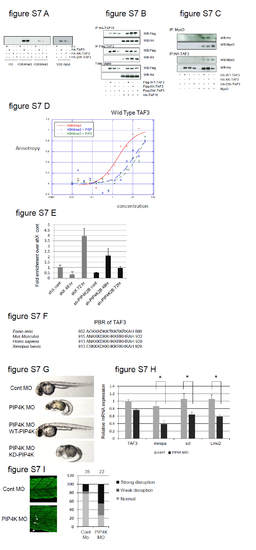Fig. S7
- ID
- ZDB-FIG-170320-19
- Publication
- Stijf-Bultsma et al., 2015 - The basal transcription complex component TAF3 transduces changes in nuclear phosphoinositides into transcriptional output
- Other Figures
- All Figure Page
- Back to All Figure Page
|
Related to Figure 7. A. HEK293 cells were transfected with TAF3 PHD finger constructs indicated (right) and lysates were used for affinity chromatography with beads coupled to unmodified histone H3 peptide (H3) or modified by trimethylation at lysine 4 (H3K4me3) or at lysine 9 (H3K4me3). Bound proteins were separated by SDS-PAGE and assessed by immunoblotting using an anti-HA antibody. The right panel depicts the input of the various TAF3 proteins. B. HEK293 cells were transfected as indicated (bottom) and then immunoprecipitated with the antibodies indicated on the left and bound proteins were assessed using SDS-PAGE and immunoblotting with the antibodies indicated on the right. The lower panel shows the expression of the various proteins in the input lysates. C. HEK293 cells were transfected as indicated (bottom) and immunoprecipitated with the antibodies shown on the left. Bound proteins were assessed by SDS-PAGE and immunoblotting with the indicated antibodies (right). D. Increasing concentrations of WT-TAF3 PHD finger was assessed for its interaction with fluorescent H3K4me3 peptide in the absence (red line) and presence of PI5P (blue line) and PI(4,5)P2 (green line). The data demonstrate that both PI5P and PI(4,5)P2 decrease the interaction between TAF3-PHD finger and H3K4me3. E. TAF3 Chip analysis at the promoter of the MYOG gene of shX or sh-PIP4K2B C2C12 cells before and after myoblast differentiation for 48h or 72h. The data is represented as fold enrichment over the shX control and are mean+SEM (n=2). F. An alignment showing the strong evolutionary conservation of the PBR of the TAF3 PHD finger from various organisms. G. Zebrafish embryos were injected with either a control morpholino (MO) or a PIP4K targeting morpholino (PIP4K MO) with or without RNA encoding the wild type human PIP4K2A (WT-PIP4K) or the kinase inactive enzyme (KD-PIP4K) and were collected 48h post fertilisation. PIP4K MO induces a developmental phenotype observed in approximately 70% of fish. The rescue was observed in 80% of injected fish with WT-PIP4K RNA but only in approximately 10% injected with the mutant kinase inactive PIP4K RNA. H. Control zebrafish embryos (cont) or embryos injected with 3.5ng PIP4K MO were collected 24h post fertilisation and assessed for the expression of the TAF3 dependent transcription factor mespa and for direct Mespa downstream gene targets scl and lmo2. The data represent fold changes compared to the control samples and represent the mean +SD of triplicates. The data were normalised to the housekeeping gene GAPDH. I. Zebrafish embryos were injected with a control- or PIP4K MO. Embryos were collected 24h post fertilisation and stained using F59 (MYHC). Representative images of the disruption of the myosin filament architecture by the indicated injections are shown. The severity of the phenotypes were categorised into strong and weak and presented graphically. The number of injected embryos is indicated above the graph. |
| Genes: | |
|---|---|
| Fish: | |
| Knockdown Reagent: | |
| Anatomical Term: | |
| Stage: | Prim-5 |
| Fish: | |
|---|---|
| Knockdown Reagent: | |
| Observed In: | |
| Stage Range: | Prim-5 to Long-pec |

